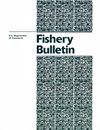Growth and related traits of the sheepswool sponge (Hippospongia lachne): practical and theoretical considerations
IF 0.8
4区 农林科学
Q3 FISHERIES
引用次数: 1
Abstract
2 Changing Oceans Research Unit Institute for the Oceans and Fisheries University of British Columbia 2202 Main Mall Vancouver, British Columbia V6T 1Z4, Canada 3 Institute of Environment and Department of Biological Sciences Florida International University 3000 NE 151 Street, AC1-213 North Miami, Florida 33181 Abstract—Fisheries for Caribbean sponge species began in the mid-1800s and landings peaked around the early 1900s before crashing because of a combination of overexploitation, disease, and hurricanes as well as, later, the introduction of artificial sponges. Still, artisanal sponge fisheries remain in Florida and areas of the Caribbean like The Bahamas, but none of those fisheries or the sponges upon which they depend are well studied. On the basis of data and information published by J. Storr in 1964 as well as of our own data, von Bertalanffy growth parameters were estimated for the most commercially valuable Caribbean sponge, the sheepswool sponge or wool sponge (Hippospongia lachne), along with related statistics, notably longevity. Also, morphological dimensional constraints that are likely to limit the supply of oxygen deep within this and other nearspherical sponge species are presented, along with the sponges’ evolutionary and ontogenic responses to these constraints. These considerations are also illustrated with data from species other than the wool sponge and are consistent with a general theory of growth for waterbreathing ectotherms, the gilloxygen limitation theory. The information provided herein should be useful for quantifying the ecosystem effect of sponge fisheries in Florida, The Bahamas, and elsewhere and for improving the management of sponge fisheries and mariculture worldwide.绵羊海绵(Hippospongia lachne)的生长和相关特性:实践和理论考虑
3佛罗里达国际大学环境与生物科学系研究所,佛罗里达北迈阿密市AC1-213号NE 151街3000号摘要:加勒比海海绵物种的渔业始于19世纪中期,在20世纪初达到顶峰,之后由于过度开发、疾病、生物多样性等因素的综合作用而崩溃。还有飓风,以及后来引入的人造海绵。尽管如此,手工海绵渔业仍然存在于佛罗里达州和加勒比海地区,如巴哈马群岛,但这些渔业或它们所依赖的海绵都没有得到很好的研究。根据J. Storr于1964年发表的数据和信息以及我们自己的数据,估计了最有商业价值的加勒比海绵,羊绒海绵或羊毛海绵(Hippospongia lachne)的von Bertalanffy生长参数,以及相关统计数据,特别是寿命。此外,形态学上的尺寸限制可能会限制这种和其他近球形海绵物种内部的氧气供应,以及海绵对这些限制的进化和个体反应。这些考虑也可以用除毛海绵以外的物种的数据来说明,并且与呼吸水的变温动物生长的一般理论——gillo氧限制理论相一致。本文提供的信息应有助于量化佛罗里达、巴哈马和其他地方海绵渔业的生态系统效应,并有助于改善全球海绵渔业和海水养殖的管理。
本文章由计算机程序翻译,如有差异,请以英文原文为准。
求助全文
约1分钟内获得全文
求助全文
来源期刊

Fishery Bulletin
农林科学-渔业
CiteScore
1.70
自引率
12.50%
发文量
76
审稿时长
>24 weeks
期刊介绍:
The quarterly Fishery Bulletin is one of the oldest and most respected fisheries journals in the world. It has been an official publication of the U.S. Government since 1881, under various titles, and is the U.S. counterpart to other highly regarded governmental fisheries science publications. It publishes original research and interpretative articles in all scientific fields that bear on marine fisheries and marine mammal science.
 求助内容:
求助内容: 应助结果提醒方式:
应助结果提醒方式:


